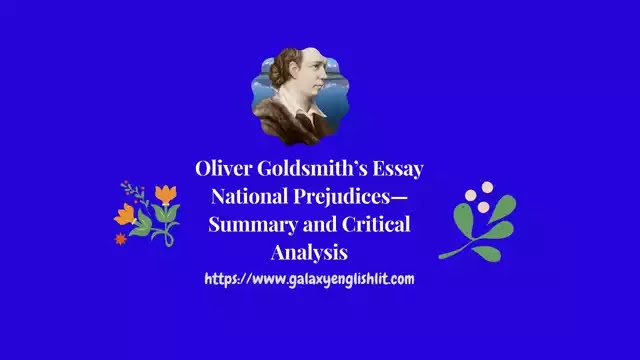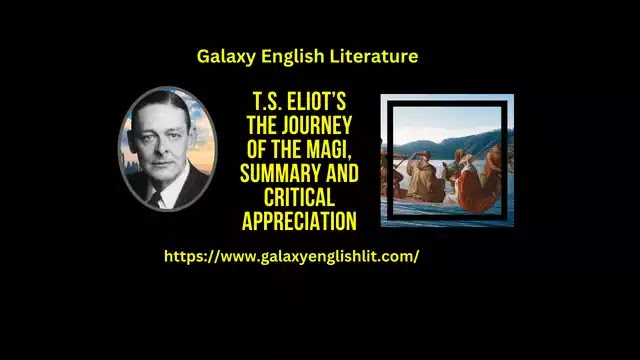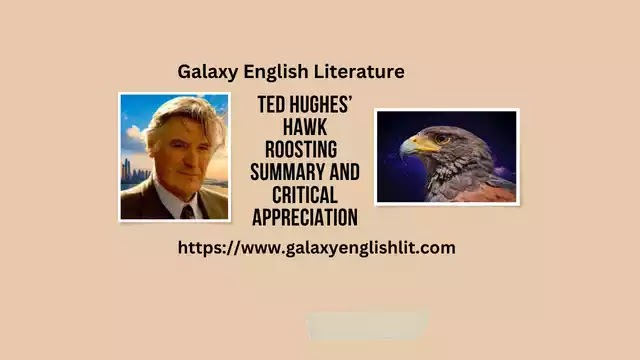Critical Appreciation of the Poem
Introduction:
The poem entitled After Blenheim by Robert Southey is an anti -war poem that centres around one of the major battles of eighteenth century - the Battle of Blenheim. The poem was written in 1796 in the form of a ballad. It offers deep insights on war and its consequences. The Battle of Blenheim was fought in 1704 in Blenheim between the English and the Austrians on the one side and the French on the other side. The battle resulted in a grand victory of the English under the Duke of Marlborough. In this fierceful battle a large number of people were killed. It brought a great destruction.
 |
| A Critical Study of the Ballad Entitled After Blenheim by Robert Southey |
Through the conversation between an old farmer, Kaspar and his grandchildren, Wilhelmine and Peterkin, the poet gradually reveals the scene of a former battlefield. One of the kids has found something ‘large and round’ which his grandfather explains is a skull, one of many to be found nearby. Similar instances run through the poem to support the main ideas - tragic end of war and vulnerability of human life. The poem makes us ponder on the purpose and result of a war and even questions its validity. The war of Blenheim caused huge devastation and thousands of casualties, but old Kaspar seems to have unconcerned attitude towards this as he claims that ‘it was a famous victory’ and ’things like that must be’. His gruesome description, followed by his casual sayings creates an effect of irony. It is ironic that it a great war but no one knows why.
Thought - Content:
One summer evening in fields around the Bavarian town of Blenheim in Southern Germany, an elderly farmer named Kaspar was sitting in front of his cottage watching his grandchildren, Wilhelmine and Peterkin, at play. Peterkin was rolling an object he found near a stream. He gave it to Kaspar and asked what it was . The old man who had found many such objects while ploughing the fields, replied that it was the skull of a soldier who died in the Battle of Blenheim. Their curiosity aroused. The children asked him about the battle. They wanted to know why it was fought. Kaspar told the children that the English defeated the French and the later generation would call it a great famous victory. However, Kaspar was at a loss to explain the cause of the battle. He knew that thousands died in it- not only soldiers but also towns people , including children . In fact, the fields were littered with corpses. But such terrible consequences are the part of war, he says. They do not negate the glory of the victory. Wilhelmine then commented that the battle was a wicked thing but Kaspar told her that she was wrong. He said that it was a famous victory. Peterkin asked him what good came of the fighting. Kaspar said that he did not know, but added that it was a famous victory.
Moral of the Poem:
The poem depicts the famous battle of Blenheim which was fought in Blenheim, a small village in Bavaria. It badly criticises the blind patriotism and false feelings of proud and glory which provoke to wage the fierceful battle at the cost of death and destruction. It moralises that the English, under the command of the Duke of Marlborough achieved a grand victory, but in true sense it was not a great and grand victory, it was a huge destruction of humanity. The war brought only death and destruction on great scale. Through this poem, the poet wants to emphasise that wars are senseless, futile and evil and that in war there is no real winner - every - body ending up being a loser. In the twenty first century, the entire world is war - ridden and poverty stricken. Thousands of killings are being reported every single day throughout the world. So, in today's world, this poem can enlighten our minds to crave for a peaceful world. It is a wake - up call to seek peaceful solutions to all conflicts.
Form and Structure:
The poem After Blenheim is a balled in form which offers a particular perspective on one of the most battles of the eighteenth century. The poet does not describe the battle directly but, through the conversation between an old farmer and his grandchildren, it gradually emerges that the setting is former battleground. The poem starts abruptly without a systematic introduction. The situation becomes clear in a very gradual way when the little boy brings a skull to the old man. Like other ballads, it is impersonal. No attempt has been made to show the writer's identity or personality. This ballad has been separated into eleven equal verses. The poet has followed the rhyming scheme abcbdd in all the stanzas except the second one. Iambic tetrameter (four iambic feet) and iambic trimeter (three iambic feet) lines alternate throughout the poem with the last two lines in each stanza being a tetrameter. This is a typical characteristic of a ballad.
The Use of Refrain:
In the poem, the poet has repeated the phrase the great victory and a famous victory with little variations. Old Kaspar continuously repeats this phrase as this is all he knows about the war. But this is certainly not what the poem is saying. Rather, Southey uses this phrase to emphasise the exact opposite that it was no not really a great victory; war can never be ‘great’. It is a highly effective way of making his point.
The Use of Irony:
The poem narrates the story of the Battle of Blenheim and the death and destruction it caused. The poem is in ironical tone where the poet presents the common people's misconceptions regarding war, how they fall prey to the propaganda that was indoctrinated in them and how they glorify war and the so - called war heroes. In the poem we see old Kaspar praise the war calling it a ‘great victory’ and a ‘famous victory’ as he has heard people say. He does not know why it was a great victory. He does not know what good war can cause to the mankind. But still he glorifies war. And what is most ironical in it is the fact that he himself was a victim of battle when his father was forced to escape with his family to save their life, losing their house and with no place ‘to rest his head’. Kaspar even feels pity of war as we see him shaking his head and having a natural sigh seeing a skull. But still we see him praise the war and say:
"But things like that, you know, must be
At every famous victory."
The Use of Figures of Speech:
The poet has used the figure of speech metonymy. Metonymy is a figure of speech in which a thing or concept is referred to by the name of something closely associated with it. In the line ‘And by him sported on the green’, ‘green’ refers to the grassland as grass is green in colour.
In several stanzas, Southey uses alliteration to promote rhythm and euphony. There are some instances of alliteration:
"Now tell us what ' twas al about,
With wonder - waiting eyes;
They say it was a shocking sight."
Archaism:
Archaism is the use of archaic or obsolete (very old and presently not in use) words. Southey's use of archaic words and apostrophe by removing a silent vowel helps to create an atmosphere of antiquity and makes the ballad more entertaining.
"Nay……… nay……my little girl,’ quoth he
But ‘twas a famous victory."





